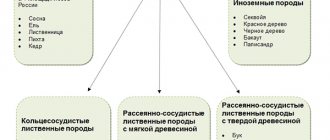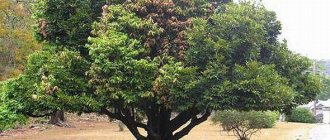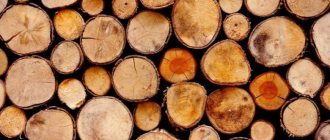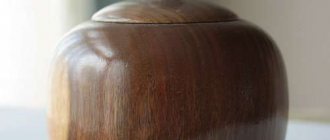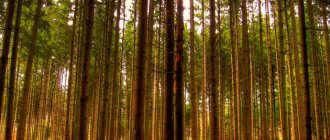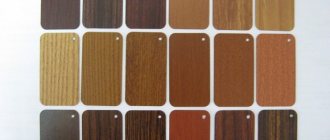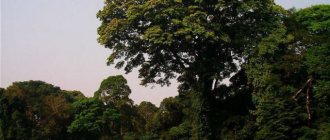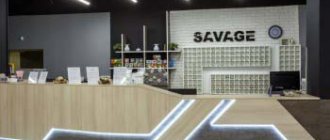Many people are attracted to things made of wood. This material allows you to achieve a unique and inimitable result, so it is always in demand.
But why are some wooden products more valuable than others? Much depends on the type of wood, which affects the final cost of the finished product.
Trees differ from each other in strength, beauty of rings, complexity of processing and rarity of the species. The more unusual and rare the tree, the more expensive it will cost the buyer.
Zebrano
This tree received its unusual name for the original color of the wood, reminiscent of zebra skin. The light brown base is intersected by many dark brown stripes.
Zebrawood is valued not only for its visual appeal, but also for its very durable structure. The combination of strength and beauty allows the material to be used for finishing the interiors of expensive cars, floors and walls in high-status offices.
Cost 1 cubic. m of zebrawood wood starts from $6,000.
Elite breeds
Russia is rich in a variety of plants, including trees and shrubs. Among them there are those who are rightfully considered elite. All this is due to their structure and positive characteristics: Hardness, ability to withstand heavy loads, original texture, degree of oxidation and many other qualities.
This wood is actively used in the manufacture of doors, floors and furniture, as well as boxes and other items. All interior items made from natural wood give the home a special atmosphere and comfort. But at the same time they require special care and investment of considerable funds.
Rosewood
The tree, whose range covers central Africa and the island of Madagascar, has wood with a soft structure. The coloring is an alternation of narrow stripes. Rosewood was once less valuable and was actively used for furniture production. Gradually, natural reserves of raw materials were depleted, the tree became rare and expensive.
Manufacturers of inexpensive furniture today paint plywood sheets and wood panels in the color of rosewood to imitate the expensive look of the product. And rosewood itself is used exclusively in the production of veneer.
Cost of 1 cubic. m of rosewood can reach up to $10,000.
Lignum vitae
Native to Cuba, Jamaica and other island territories of the Caribbean and also called "ironwood", buckout is an incredibly strong and heavy wood that can withstand extreme mechanical pressure. It does not deteriorate with prolonged contact with water, therefore in past centuries it was used in the construction of sea vessels.
Today, backout is a material used by gunsmiths to turn the handles of elite edged weapons.
For 1 cubic m of backout wood costs approximately $80,000.
Umnini
The wood has a unique rich pink color, which is why it is nicknamed “pink ivory”. The tree, which belongs to the buckthorn family, grows in the southern and southeastern regions of Africa.
The material is applicable in the creation of handles for collectible edged weapons, billiard cues, and exclusive decorative elements. The color range ranges from faded brown-pink to rich red, but bright pink wood is considered the most valuable.
On the world market, per board foot (0.00236 cubic meters) umnini are asking up to $8,000.
Amaranth
Another type of plant with wood of a unique color - purple. Belongs to the Legume family and grows in the hot and humid climate of South America and the Isthmus of Panama. The wood, called “purple heart,” acquires its original color after drying.
Amaranth is used to decorate premises, make exquisite decorative items, and elements of sports equipment. The sensitivity of the material to ultraviolet radiation should be taken into account. Today, 13 varieties of amaranth wood are sold.
A board foot of purple heart costs $12,000.
Grenadil
A woody plant belonging to the genus Dalbergia, a family of legumes, native to southeastern Africa. Africans call the tree with the reddish-black heart mpingo.
Grenadile wood has been of high value since ancient times. Thanks to its excellent acoustic properties, it is used in the production of musical instruments, as well as luxury furniture and decorative elements. The activities of poachers have led to the fact that the grenadile species has almost disappeared; its sale is strictly regulated by law, which makes the cost even higher.
Grenadil is not the only valuable species of the Dahlbergia genus. Also worth noting are the cocobolo with wood of a beautiful cherry color and the bahia tree with a pinkish core.
The price of 1 kg of black grenadil wood is $10,000.
Mahogany
One of the most valuable wood species. The red material of various shades is distinguished by its unusual pattern - from rays and wavy stripes. Expensive furniture, percussion musical instruments, and finishing materials are made from mahogany. Recently, they have become very popular in decorating ship cabins. The breed is distinguished by its noble appearance and obedience: mahogany is easy to saw, process, polish and sand. It is believed that musical instruments made from mahogany sound clear and deep.
These are not all tree species recognized as valuable.
The list is actually very extensive: sequoia, yew, sandalwood, rosewood - these trees grow on different continents and are used for different purposes. But they have one thing in common: the popularity of unusual wood makes them increasingly rare. To the listNext articlePrevious article
Macassar
This tree with massive, incredibly durable wood grows on the Indonesian island of Sulawesi. The material is so heavy that it sinks in water. Its value lies not only in this, but also in its external beauty. Thanks to its unusual red and black striped color, the wood is used in the manufacture of musical instruments, exquisite decorative elements, and in the decoration of offices and other high-status premises.
Cost of 1 cubic. m of Macassarra wood reaches $100,000.
Oak
The hardest, most reliable, wear-resistant and dense - 760 kg per cubic meter. There are legends about the durability of products made from this breed. Even in Latin the name of oak is translated as “beautiful tree.” Its porous structure looks very noble, but at the same time it can resist rotting and parasites. Over time, oak wood darkens, which looks even more aesthetically pleasing. Considering all the advantages, one should not be surprised that this breed is very capricious: oak furniture requires special attention and care, it will not agree to just stand and become covered in dust at home. The happy owner of oak products must treat their surface with special products at least once a month, for which the oak will be ready to serve the owner for decades.
Oak was in demand several centuries ago. In the Peter the Great era, for example, poaching the felling of this tree was punishable by death. Times have changed, but oak has become even more widely used: in interior decoration, building construction, furniture, doors, underwater structures and flooring. Garden furniture made from this wood and oak bathhouses are especially popular now. And, of course, such interior elements as an oak dining table, chairs and a secretary remain timeless classics.
Eben
The ebony tree, growing in small areas in Africa, southern India and Sri Lanka, is included in the Red Book. The sale of its wood is strictly regulated at the state level, but this is not the only reason for the high price of the material.
The plant, which looks more like a large shrub, was highly valued by the Egyptians and other ancient peoples. Its wood is easily mechanically affected, does not deteriorate from prolonged contact with water, and after polishing shines like a mirror.
Price for 1 cubic meter m of ebony wood exceeds $100,000.
Construction wood
Depending on what kind of wood you choose as a material for the walls, your house can last only 40-50 years or become a reliable shelter for several generations. Although, of course, compliance with construction and finishing technology, proper operation of the building, and timely repairs are also important. And most importantly - the quality of the material itself.
Note. These days, fresh debarked logs are used less and less. Preference is given to laminated veneer lumber or dried round logs. Such materials, having undergone pre-treatment, are less susceptible to drying out, cracking, rotting and damage by insects.
All over the world, coniferous trees are most often used to build houses, while deciduous trees are used for the manufacture of interior structures and finishing. Let's take a closer look at them.
Coniferous wood
The most common types of construction wood are pine, spruce, cedar and larch. Due to their high resin content, they resist harmful influences well, are more durable, and their properties are determined by such parameters as the hardness and density of coniferous wood.
The table describes all the advantages and disadvantages of each type.
| Wood type | Advantages | Flaws |
| Pine | The most common and inexpensive breed used for construction in almost all countries of the world. Refers to soft, low-drying, dense varieties. It has a smooth trunk with a small number of knots, wear resistance, resistance to rotting and cracking. | Susceptible to blue mold, which has little effect on the quality of the wood, but negatively affects the appearance. |
| Spruce | It has a loose structure, so it retains heat well. The wood is soft and shrinks slightly when dried. It has antibacterial properties; the released phytoncides have a positive effect on human health and well-being. | Wear resistance is average, prone to rotting when exposed to moisture. Needs additional protection using moisture-repellent or film-forming agents. Not suitable for lower crowns. The trunk is knotty, which complicates harvesting and processing. |
| Larch | If we evaluate the hardness of wood species, then among conifers larch has the highest, due to which it has:
It’s easy to breathe in a larch house, and many people note improved health. | Wood dries out greatly over time. The main disadvantage is the high cost of the material compared to pine and spruce. |
| Cedar | The wood is soft but durable, almost does not crack, does not rot, and does not absorb moisture. Resistant to microorganisms, insects, aggressive atmospheric and chemical influences, does not deform due to temperature changes, and is easy to process. Releases essential oils with healing properties. | The high price, as a result of which cedar wood is often used not for construction, but for finishing residential premises. |
As you can see, almost all conifers are soft woods. They are easy to process: sawing, grinding, cutting. They are durable, resist moisture well, behave better when dried, giving slight shrinkage. Therefore, they are a priority for use as materials for load-bearing structures.
Hardwood
In principle, any hardwood is suitable for construction if we are talking about temporary buildings or buildings that do not have high requirements for thermal insulation and durability.
In the case of residential buildings, hardwood trees such as oak and birch are considered relatively suitable, and softwood trees are aspen and alder.
- Oak is an exceptionally durable, strong and reliable material, highly resistant to moisture and other weather conditions. It is not susceptible to rotting, is not affected by mold and other microorganisms, has excellent abrasion resistance, and its wood has a pleasant color and texture. But, despite all these positive qualities, it is rarely used for the construction of walls, as it is quite expensive. More often, only the lower crowns are made from it, and the rest are raised from less valuable wood.
For reference. Solid but elastic oak wood is the best material for making parquet, doors, wall panels and, of course, furniture. Such products are not cheap, but they pay off with unsurpassed quality and many years of operation.
- Birch also has hard and durable wood, but it is highly deformed when dried and is difficult to process. In addition, it is short-lived - in natural conditions it is not able to withstand the effects of moisture and is susceptible to rotting. It is possible to build from it, but the lower crowns must be made of oak, larch or other durable materials, and the facades need protection. But it has proven itself well as a raw material for the manufacture of interior finishing materials and furniture.
Birch logs
- Aspen is not at all afraid of moisture, it does not warp when dried, it can be easily processed by hand and pleases the eye with its pleasant color and pattern. But due to the relatively low durability and susceptibility of wood to diseases, it is used mainly for the manufacture of individual structural elements and for the construction of saunas, baths, well log houses, basement walls and cellars.
Aspen lumber is the best product for the construction and interior decoration of bathhouses
Note. For these purposes, it is recommended to take well-dried “mature” wood that is at least 40 years old.
- Alder is the lightest wood with low density and uniform texture, suitable for construction on weak foundations. It is quite durable and moisture-resistant, but still not popular as a building material. But if we talk about wood species for furniture and facing materials, alder occupies one of the leading places on the list.
The garden furniture in the photo is made of alder
Sandalwood
The subtle aroma of sandalwood is known to every perfume connoisseur. The high cost of sandalwood is due to its aromatic properties. Oil is prepared from it, used in cosmetology and perfumery, and the material itself, which has a pleasant pinkish tint, is used in the production of parts for expensive furniture and souvenirs. The emitted woody aroma, reminiscent of a mixture of lemon, rose and musk, lasts for several years.
Sandalwood is a rare tree, on the verge of extinction. For 1 kg of raw materials, buyers pay about $20,000.
Teak
Teak cabinets in sleek modern kitchen
This is a great opportunity to bring the color and majesty of the tropics into your home design. Teak, the national tree of the Philippines, is a very hard wood species. It is characterized by greenish, yellow and brown shades.
The application is very diverse: doors, window frames, home and garden furniture. Often, during the process of aging and maturing, the treated teak surface acquires a silver-gray tone. Doesn't remind you of anything?
Bokota
The tree is quite rare, its range covers only some areas of Mexico and the Caribbean. Wood is very popular among manufacturers of luxury decorative products, which is why its cost is constantly growing and has already become the highest in the world.
Bocotte wood is notable for its original and incredibly beautiful color: the base is greenish-yellow, with dark spots and stripes spreading across it, forming intricate patterns. The material is dense, heavy, resinous, and is close in quality to African black wood.
The Bokota species will most likely face the same fate as other valuable breeds - almost complete extinction. In the meantime, on the world market they are asking $33,000 per board foot.
Most tree species with valuable timber are rare and endangered. This largely explains their high price. The sale of such material is strictly regulated, and only wealthy people can afford to purchase products made from it.
Bubinga - a precious finishing material
Bubinga is a tree of the Guibortia species from the legume family. It grows in Africa and South America, in tropical regions. Bubinga has many other names: akume, ebana, essingang, kevazingo, huaca. In total, this group of plants includes 16 species. The bubinga core is very beautiful. Its peculiarity is the constant change in fiber growth, which results in a wavy texture. The growth rings are clearly visible, which adds color to the texture.
Shades can be different, in red colors. The background is mostly red-brown; there may be stripes of purple or marsala. Bubinga is traditionally used to make guitars, harps, and drums. It is also used to finish the interior parts of Lexus and BMW cars. High strength allows the material to be used for the production of knife handles and hunting bows. The large size of the core makes it possible to make solid table tops from it.
